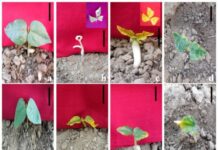A recent article by Mabungela et al., (2023) titled “Multi-application of fennel (Foeniculum vulgaris) seed composites for the adsorption and photo-degradation of methylene blue in water” published in South African Journal of Chemical Engineering, shows that fennel seeds were modified with iron oxide nanoparticles and iron-tetracarboxylic acid to enhance their adsorption capacity and photocatalytic activity.
“
Fennel seed composites, modified with iron oxide nanoparticles, exhibit superior adsorption and photocatalytic activity for efficient methylene blue removal in water.– Mabungela et al., 2023
This study explores fennel-based composites for methylene blue removal and degradation in water. Modified with iron oxide nanoparticles and tetracarboxylic acid, fennel seeds exhibit enhanced adsorption and photocatalytic activity. The cationic dye, a threat to health and the environment, is effectively removed through adsorption and photodegradation processes. Adsorption kinetics follow Freundlich and pseudo-second-order models, suggesting heterogeneous adsorption and chemical interactions. Photodegradation, which is more efficient with FS-NP, involves reactive oxygen species attacking dye molecules under LED light. Characterization techniques confirm composite formation and interaction with methylene blue, utilizing Scanning Electron Microscopy (SEM), Transmission Electron Microscopy (TEM), Fourier Transform Infrared (FTIR), spectroscopy, X-ray diffraction (XRD), Energy Dispersive X-ray Spectroscopy (EDX), Brunauer-Emmett-Teller (BET), and Inductively Coupled Plasma (ICP) analyses. The study aimed to synthesize fennel-based composites and test their feasibility to remove and photo-degrade methylene blue dye from an aqueous solution.
How the Study was Conducted
The study employed fennel seed waste as the raw material, which was rinsed, defatted, ground, and sieved to obtain pristine fennel seeds (PFS). The authors impregnated PFS with iron(III) oxide nanoparticles (Fe2O3 NP) and iron(III)-1,2,3,4-tetracarboxylic acid (Fe-TCA) to obtain the composites fennel seeds-nanoparticles (FS-NP) and fennel seeds-tetracarboxylic acid (FS-TCA), respectively. The study characterized the adsorbents using various analytical techniques, such as SEM, TEM, FTIR, XRD, EDX, BET, and ICP. The authors performed adsorption experiments in a batch system by varying the parameters such as the initial concentration, contact time, pH, and temperature of the methylene blue solution. The authors analyzed the adsorption data using different isotherm and kinetic models and calculated the thermodynamic parameters to evaluate the adsorption mechanism and feasibility. The study tested the reusability and regeneration of the adsorbents by using acid treatment and distilled water washing. The study employed photo-degradation experiments by exposing the dye-loaded composites to LED light and monitoring the degradation efficiency and kinetics.
What the Authors Found
The authors found that fennel seeds were modified with iron oxide nanoparticles and iron-tetracarboxylic acid to enhance their adsorption capacity and photocatalytic activity. The authors posits that the composites showed higher adsorption capacity than pristine fennel seeds at different concentrations, pH, and temperatures of methylene blue solutions. The adsorption process followed the Freundlich isotherm and the pseudo-second-order kinetic model, indicating heterogeneous and chemisorption mechanisms. The study also found that the composites exhibited photocatalytic degradation of methylene blue under LED light irradiation, while pristine fennel seeds showed no activity. The photocatalytic process followed the pseudo-second-order kinetic model, suggesting that the rate-limiting step was the surface reaction between the dye and the photocatalyst. In addition, the results showed that the composites were reusable and regenerated by acid treatment, demonstrating their potential for practical applications in water treatment.
Why is this important
The study demonstrates the potential of fennel-based composites as low-cost and eco-friendly materials for water treatment, especially for the removal and degradation of methylene blue dye, which is a common water pollutant from various industries. The study also reveals the effects of different modifications on the fennel seeds, such as impregnation with iron oxide nanoparticles and iron-tetracarboxylic acid, which enhance the adsorption capacity, surface area, cation exchange capacity, and photocatalytic activity of the adsorbents. The study provides insights into the adsorption and degradation mechanisms of methylene blue by the fennel-based composites, such as chemical interactions, electrostatic attraction, π-π stacking, and generation of reactive oxygen species. The study contributes to the development of novel and effective plant-based materials for water purification, which could have significant environmental, economic, and social benefits.
What the Authors Recommend
- Using fennel-based adsorbents for water treatment. The authors suggest that fennel seeds waste can be utilized as a low-cost and effective material for the removal and photodegradation of methylene blue dye from aqueous solution.
- Enhancing the adsorption potential of fennel seeds by impregnation. The authors report that the adsorption capacity of fennel seeds was improved by defatting the seeds and impregnating them with iron(III) oxide nanoparticles and iron(III)-1,2,3,4-tetracarboxylic acid.
- Investigating the multi-application of fennel seed composites. The authors propose that the fennel seed composites can be used for both adsorption and photocatalytic degradation of methylene blue, as well as for the removal of other pollutants such as metal ions and organic compounds.
- Exploring the feasibility of using other plant-based materials. The authors indicate that other agricultural wastes and natural polymers can be modified and used as adsorbents and photocatalysts for water treatment.
In conclusion, the groundbreaking study by Mabungela et al. (2023) highlights the remarkable potential of fennel-based composites as a sustainable and cost-effective solution for water treatment. Through innovative modifications with iron oxide nanoparticles and tetracarboxylic acid, fennel seeds demonstrate enhanced adsorption capacity and photocatalytic activity, proving effective in removing and degrading the common water pollutant, methylene blue. The findings not only shed light on the intricate mechanisms involved, such as chemical interactions and surface reactions but also emphasize the broader applications of these eco-friendly materials. This research paves the way for a greener approach to water purification, showcasing the versatility and promise of plant-based adsorbents in addressing environmental challenges and promoting a cleaner, healthier future.
















 The African Research (AR) Index is a comprehensive scholarly directory and database focused explicitly on journal publishers that publish and disseminate African research.
The African Research (AR) Index is a comprehensive scholarly directory and database focused explicitly on journal publishers that publish and disseminate African research.

